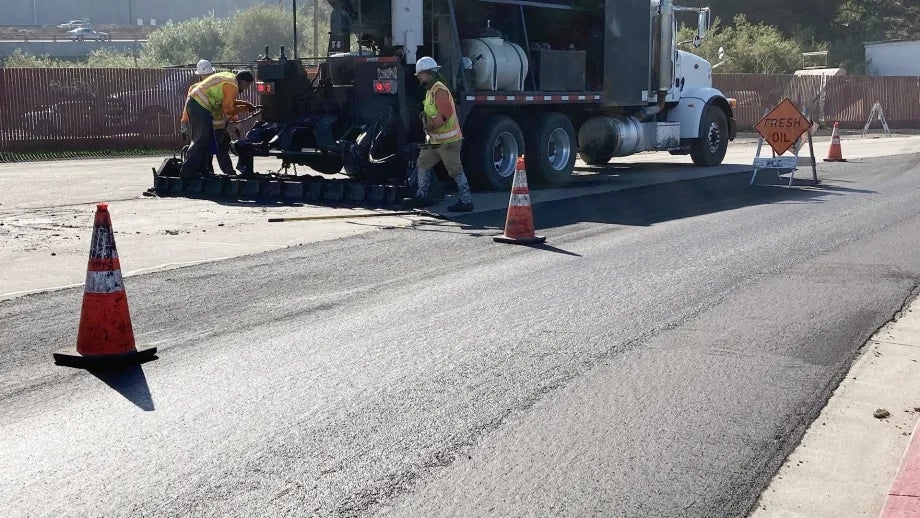Surface Transportation Law
Federal funding — as authorized by the Infrastructure Investment and Jobs Act (known as the Bipartisan Infrastructure Law, or BIL) — is essential to keeping the Bay Area moving.
While federal transportation dollars account for less than 10% of the Bay Area’s total planned transportation investments, the Bay Area depends on this money for transit, road repair, safety and mobility projects throughout our 101 cities and nine counties.
Bipartisan Infrastructure Law (BIL) Transportation Components
There are two key surface transportation components to the BIL:
- A roughly $475 billion five-year surface transportation reauthorization. This is a 56% increase above Congress’s last five-year transportation bill, the Fixing America’s Surface Transportation (FAST) Act.
- Supplemental one-time stimulus funding to be distributed through more than two dozen grant programs over five years.
The Bay Area will receive about $4.5 billion in “guaranteed” funding over five years through the highway, bike/pedestrian and transit formula funds that MTC distributes.
MTC also expects Bay Area projects to receive a share of the state’s $4.2 billion in bridge repair funds and dedicated resources for zero emission vehicle charging and resilience projects.
The scale of new discretionary grants to be funded through the BIL and administered by the U. S. Department of Transportation (USDOT) is unprecedented. The law authorizes some $140 billion in competitive grants that could help fund Bay Area transportation priorities identified in Plan Bay Area 2050 — everything from Vision Zero to high-speed rail.
Investing in Transit
The BIL will greatly increase the Bay Area transit resources, providing $3.4 billion over five years — up from $2.3 billion under the previous FAST Act — to help maintain aging rail, bus and ferry infrastructure. MTC distributes these funds through the Transit Capital Priorities program. Bay Area operators will also be able to compete for the billions of dollars in new "Fix it First" grants.
The BIL nearly doubles the Capital Investment Grant program authorization, which, for decades has helped to fund nearly every major transit modernization project in the Bay Area. It also provides tens of billions of dollars in supplemental grants that could be used to fund everything from zero-emissions buses to integrating future California High-Speed Rail into the Bay Area’s regional transit network .
Flexible Highway Funds
MTC will receive a modest boost in flexible Surface Transportation Block Grant (STP) and Congestion Mitigation and Air Quality Improvement (CMAQ) program funds to advance Bay Area transportation projects that:
- Improve safety
- Spur economic development
- Help the region meet climate change and air quality improvement goals
MTC invests these flexible highway dollars through the One Bay Area Grant (OBAG) program. OBAG improves mobility for Bay Area residents and also incentivizes critical new housing production in the region.
Active Transportation & Safety
Bay Area bicycle and pedestrian projects will receive a minimum of $72 million in federal assistance through the BIL, a nearly 90% increase from the previous five-year bill. MTC distributes this mooney through the regional Active Transportation Program (ATP), which is supplemented by state resources. Bay Area bike and pedestrian projects also may compete for statewide ATP funds, which also got a boost from the BIL.
The bill increases California’s road safety funding by roughly 25%, a portion of which is distributed to Bay Area local priorities through the state’s local assistance safety program. Among other new safety programs is a $5 billion grant program for Vision Zero plans and projects.
Climate & Resilience
The BIL’s historic investment in transit and bike/pedestrian projects will go a long way in combating transportation-related emissions. The federal transportation program for the first time explicitly directs resources toward fighting climate change. The Bay Area would receive $70 million over five years through the new Carbon Reduction Program to lower greenhouse gas emissions.
Additionally, California will receive $380 million to build out electric vehicle charging infrastructure. Up to $2.5 billion of California’s new BIL funding could be used to improve transportation infrastructure resilience.
BIL invests in several new or expanded climate-focused grant programs, including:
- Low- and zero-emission buses ($5.6 billion)
- Port electrification and other improvements ($2.6 billion from multiple programs)
- Electric vehicle charging infrastructure ($2.5 billion)
- PROTECT resilience grants ($1.4 billion)
- Ferry electrification (up to $500 million)
Competing for Bipartisan Infrastructure Law Grants
The BIL authorizes $140 billion in new grant funding for which Bay Area surface transportation projects can compete. The USDOT will distribute funds over five years through more than two dozen targeted competitive grant programs. The many programs aim to achieve varying goals — everything from reducing traffic congestion to advancing equity — which means that grants could fund a wide range of Bay Area priorities.
Transportation Investment Strategies
OBAG guides how MTC distributes the Bay Area’s flexible federal highway formula funds to transportation projects and programs throughout the Bay Area.
MTC distributes the Bay Area’s guaranteed federal transit funds (Section 5307, 5337 and 5310) through the Transit Capital Priorities Program. This "state of good repair" program keeps our transit infrastructure (buses, rail cars, tracks, etc.) in shape.
The BIL authorizes $23 billion in Capital Investment Grants that could help fund large-scale Bay Area surface transportation priorities. Bay Area transit and intercity rail projects also can compete for tens of billions of dollars in other BIL transit, rail and multi-modal grant funding.
Visit the following USDOT websites for additional BIL information:
- Federal Highway Administration (FHWA)
- Federal Transit Administration (FTA)
- Federal Railroad Administration (FRA)

